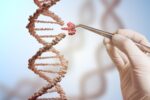Genetically Activating Fetal Hemoglobin May Be Promising SCD Therapy

Disrupting a specific area of the gene that encodes for adult hemoglobin — which is faulty in people with sickle cell disease (SCD) — led to an increase in the production of fetal hemoglobin, a version of the protein normally produced during fetal development, which can help relieve disease symptoms, according to a new study.
These data support the development of therapies that selectively target and reduce faulty adult hemoglobin gene activity to stimulate fetal hemoglobin production and alleviate the symptoms of SCD and other hemoglobin-related disorders, researchers say.
“What this really helps us to do is understand this process of turning off [fetal] globin and turning on adult globin and how we could reverse that, so that we can use this understanding of the mechanism to help us look for new therapeutic approaches — it’s a key piece of the puzzle,” Kate Quinlan, PhD, the study’s co-lead, from the University of New South Wales in Australia (UNSW), said in a university press release.
The study, “Disrupting the adult globin promoter alleviates promoter competition and reactivates fetal globin gene expression,” was published in the journal Blood.
SCD and beta thalassemia are genetic conditions referred to as beta-hemoglobinopathies that are caused by mutations in the HBB gene. This gene encodes beta-globin, a part of hemoglobin — the protein in red blood cells that transports oxygen throughout the body.
In SCD, a mutated form of hemoglobin deforms the shape of red blood cells, making it difficult for them to pass through small blood vessels, potentially slowing or blocking blood flow. Beta thalassemia is characterized by a reduction in the production of hemoglobin.
“Sickle cell disease and beta thalassemia, a closely related disease, are inherited genetic conditions that affect red blood cells,” said Quinlan. “They are fairly common worldwide — over 318,000 infants with these conditions are born every year.”
Because these mutations affect the adult version of the HBB gene, most newborns do not show symptoms. Their bodies are still producing a healthy fetal version of hemoglobin that is more effective at transporting oxygen than its adult counterpart.
“Interestingly, when children are born, they don’t show disease symptoms at first, even if they have the mutations, because, at that stage, they’re still expressing [fetal] globin and not yet adult globin,” Quinlan said. “That’s because we have different [hemoglobin] genes that we express at different stages of development.”
“As the [fetal] globin gets turned off, and adult globin gets turned on — which happens within about the first year of life — the symptoms start to manifest,” Quinlan added.
In rare cases, some people have a benign condition called hereditary persistence of fetal hemoglobin (HPFH) — marked by the ongoing production of fetal hemoglobin beyond infancy — which eases symptoms of SCD and beta thalassemia.
“In these patients, the persistent expression of [fetal] globin effectively compensates for the defective adult globin — but up until this piece of research, we didn’t really understand the process that led to this incredible advantage,” noted Quinlan.
Working in the laboratory run by Merlin Crossley, PhD, and together with collaborators in the U.S., Quinlan set out to understand the mechanism underlying ongoing fetal hemoglobin production with the aim of finding ways to maintain it in SCD and beta thalassemia patients as a therapeutic strategy.
“The goal of our research is finding out how we can reverse the [fetal] to adult globin switch, so that patients continue to express [fetal] globin throughout life, rather than the mutant adult globin genes that cause blood cells to become stiff and block vessels,” Quinlan said.
First, the team examined the genomes of people with HPFH and discovered one DNA region immediately adjacent to the HBB gene that was deleted in all cases. This region was the gene’s promoter — a segment of DNA where regulatory proteins bind and turn on the HBB gene to produce beta-globin.
To investigate further, the CRISPR gene-editing tool was used to purposefully edit or delete some areas of the promoter in cells and observe the outcome.
“CRISPR allows us to ‘cut’ bits of DNA out of cells grown in the lab, to modify genes and see what happens as a result — it’s essentially a tool to figure out what genes do inside living cells,” Quinlan said.
After editing or deleting some of the elements within the promoter region, the team found that nearly all mutations that reduced ΗΒΒ promoter activity led to an increase in fetal hemoglobin production.
“We found that deleting just that one little bit was sufficient to make [fetal] globin go up and adult globin down — which suggests that we have found the key mechanism that can explain why [fetal] globin levels remains high in these asymptomatic patients,” said Quinlan. “Effectively, by deleting the adult globin ‘on switch’, we made the [fetal] globin ‘on switch’ active.”
These data suggested that “targeting the ΗΒΒ promoter might be explored to elevate fetal globin and reduce sickle globin expression as a treatment of [beta]-hemoglobinopathies,” the team wrote.
Recently, Quinlan and Crossley received a $412,919 grant (about $300,000 USD) to fund a collaboration that will continue to explore these results, which Quinlan noted were unexpected.
“It was surprising to see the findings — many people have studied these mutations for many years, so the idea that there’d be one unifying hypothesis that could explain them rather than them all working through different mechanisms will be surprising for the field,” said Quinlan.
“While we went in with the hypothesis that there might be one mechanism, we didn’t expect it to come out so cleanly — we thought that perhaps it would be more complicated than what we’d initially thought.”








